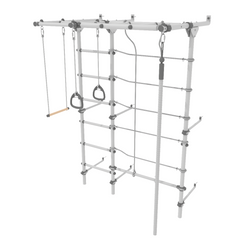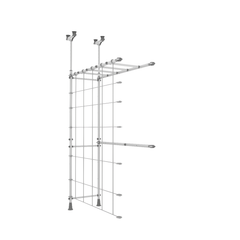Key Takeaways:
- Movement Strategy: Short, repeated movement breaks help kids with ADHD stay focused, regulated, and more emotionally balanced throughout the day.
- Indoor Equipment: Modular home play gyms provide safe, accessible ways to support climbing, swinging, and sensory input inside real living spaces.
- Routine Support: Building movement into daily routines improves transitions, focus, and self-regulation without needing formal structure or schedules.
Kids with ADHD often need to move more than their peers. That movement is how their brain processes information, manages energy, and stays regulated. Whether it's climbing, swinging, or jumping, giving them a space to move helps reduce restlessness and improve focus. The challenge for many families is finding ways to support that need indoors, especially during busy days, poor weather, or limited outdoor access.
At Brainrich Kids, we design indoor movement systems that work. Our equipment is built for real homes, approved by occupational therapists, and designed to help kids move in ways that support attention and sensory regulation. Our indoor home gym systems are modular, durable, and trusted by families who need practical solutions that support everyday routines. For kids with ADHD, we don’t just offer options for play. We offer tools that support how they function at home.
In this piece, we will be discussing ADHD activities for kids, how movement supports focus and self-regulation, and how to create simple indoor routines using the right equipment.

Why Movement Matters For Kids With ADHD
Kids with ADHD often struggle with restlessness, impulsivity, and focus. Movement is one of the most effective ways to help regulate those challenges. Physical activity helps activate the brain systems responsible for attention, emotional control, and executive function. Research suggests that structured movement supports:
- Improved focus and sustained attention
- Reduced hyperactivity and impulsive behavior
- Better emotional regulation
- Increased body awareness and coordination
For many kids with ADHD, sitting still for long periods is unrealistic. Movement is not a distraction. It is a tool. When used intentionally, it can reset the nervous system, release excess energy, and support smoother transitions between tasks.
Indoor play systems like those in our indoor home gym collection make it easier for children to move throughout the day. That level of access is especially helpful for kids who benefit from frequent, self-directed activity in a safe environment.
Best Indoor ADHD Activities For Kids
Not all activities are equally effective for kids with ADHD. The most helpful options combine movement, decision-making, and sensory input. These activities engage the body and mind while supporting focus and calm. Here are some effective indoor activities for kids with ADHD:
Climbing And Swinging
Both activities help regulate the vestibular system, improve balance, and provide calming input. A compact indoor play gym gives kids access to both throughout the day.
Obstacle Courses
Use household items like pillows, mats or small furniture to create a path for climbing, crawling, and jumping. This builds coordination and motor planning skills.
Timed Challenges
Short sets of structured activity, such as jumping jacks or crab walks, can help release excess energy while maintaining focus.
Indoor Swings
Swinging supports sensory regulation and body awareness. We break this down in detail in our post on the five benefits of having indoor swings for kids. Adding short bursts of physical activity during the day helps kids stay regulated, engaged, and better prepared for tasks that require focus or sitting still.

How Indoor Swings Support Focus And Regulation
For many kids with ADHD, movement is not optional. It is a core need. Indoor swings offer a simple, consistent way to provide calming input without needing to leave the house or change routines. Swinging helps regulate the vestibular system, which is responsible for balance and movement awareness. That system plays a key role in how kids control their bodies and maintain attention. A slow, repetitive swinging motion can have a calming effect, while a faster pace may help energize or reset the brain. Indoor swings are also helpful because they offer:
- A single-purpose, go-to activity that kids can use when overwhelmed
- Sensory input that supports transitions between tasks
-
A quiet space for self-regulation without needing adult direction
When swings are integrated into a larger setup like a Brainrich Kids indoor home gym, they become part of a daily rhythm. Kids learn to use the swing when they need a break, when their focus drops, or when their body feels unsettled. This kind of self-guided movement is a practical support tool for ADHD. It meets the child's need for motion while encouraging independence.
Setting Up A Movement Space At Home
Creating a space for movement indoors doesn't require a full remodel. It just needs to be intentional. For kids with ADHD, access to movement should be quick, consistent, and safe. A designated area helps make that possible without disrupting the rest of the home. Start by identifying a spot that offers enough floor space and vertical clearance. A corner of a bedroom, playroom, or basement can work well. Keep the area free from clutter to reduce distractions.
Key elements to include:
- A stable frame for climbing and hanging
- A swing that can handle daily use
- Soft flooring or mats for safety
- Visual simplicity to avoid overstimulation
The Brainrich Kids indoor home gym is designed to fit into real living spaces. It uses vertical tension, so no drilling is required. Setup takes time and two people, but it doesn’t need any special tools or experience. Once installed, the gym becomes part of your child's daily routine. It's always there, ready to support movement breaks, sensory regulation, or just play when needed.
What To Look For In ADHD-Friendly Equipment
Choosing equipment for a child with ADHD means looking beyond entertainment. The goal is to support regulation, focus, and body awareness through active use. The right features make a big difference in how effective the setup will be. Here are qualities to look for:
- Multiple movement options: Equipment should offer climbing, swinging, hanging, and other ways to move. This helps address different sensory needs throughout the day.
- Modular design: A system that adapts to your child’s growth and changing needs is more sustainable than one-size-fits-all equipment.
- Durable materials: Look for strong, weight-bearing frames made from steel or similarly sturdy materials. These support longer use and are safer during high-energy play.
- Therapist-reviewed design: Products reviewed by occupational therapists are more likely to meet sensory and developmental goals.
-
Ease of access: If a child can use the equipment without help, they are more likely to turn to it when they need to move or regulate.
The Brainrich Kids system meets all of these needs. It’s designed for daily, in-home use and gives kids with ADHD the tools they need to stay physically and emotionally balanced.
How Brainrich Kids Supports Active Play Indoors
At Brainrich Kids, we design equipment with a clear goal to make daily movement accessible, purposeful, and safe for every child. Our systems are made to meet the needs of kids who benefit from structure and physical input, including those with ADHD and sensory challenges.
Our indoor play gyms are reviewed by occupational therapists and built to support real movement. That includes climbing, swinging, hanging, and sliding in one modular setup. Each unit is crafted from high-grade steel and designed for long-term use inside real homes. We also offer guidance on how to build routines around movement. Our goal is to make the equipment a part of your family’s daily rhythm, not a special-use item that gets forgotten. Indoor movement matters, and we’re here to support families who need practical, high-quality solutions.

Final Thoughts
Movement is not a luxury for kids with ADHD. It is a necessity. When used with purpose, indoor activities like climbing, swinging, and jumping can support focus, improve emotional regulation, and reduce daily frustration. The goal is not to tire kids out. It is to give them consistent ways to manage energy, stay engaged, and build control.
At Brainrich Kids, we understand the challenge of supporting these needs at home. Our equipment is designed for real spaces and daily use. It gives kids the ability to move when they need it, without waiting for the right weather or schedule. Whether used as part of a daily routine or during high-energy moments, movement supports a calmer and more balanced day.
With the right activities and setup, a home can become a place that supports regulation, not just rest. This shift can improve the experience for both the child and the family.
Read Also:
- Six Types Of Sensory Swings For Your Brainrich Kids
- Best Pull Up Bar For Kids
- Five Benefits Of Having Indoor Swings For Kids
Frequently Asked Questions About The Best Indoor ADHD Activities for Kids
What type of indoor play helps kids with ADHD the most?
Movement-based play that includes climbing, swinging, or balancing tends to support focus, regulation, and attention better than passive indoor activities.
How often should kids with ADHD have movement breaks indoors?
Many children benefit from short movement breaks every 30 to 60 minutes, especially during tasks that require sitting or focus.
Is it safe to let my child swing or climb unsupervised?
Even with safe equipment, children should be supervised while using indoor swings or climbing structures, especially during the early stages of use.
Can indoor play support transitions between school and home?
A few minutes of physical activity can ease the shift from structured school tasks to home routines and reduce resistance or meltdowns.
Do all kids with ADHD enjoy movement-based activities?
Most do, but not all. It helps to offer options and let the child choose what feels good in the moment, swinging, climbing, or jumping.
What indoor activities are helpful during screen breaks?
Timed physical challenges, obstacle courses, and swinging help reset the brain and reduce overstimulation from screen exposure.
Can indoor swings help with bedtime routines?
Slow, repetitive swinging often helps the nervous system wind down and can make it easier for children to fall asleep.
Are there quiet indoor activities that still support regulation?
Deep pressure activities like wall sits, crawling through tunnels or using resistance bands offer sensory input without noise or intensity.
What if I don’t have a full playroom?
Compact indoor gyms are designed for shared spaces. A small area with vertical clearance is often enough for an effective movement setup.
Can these activities benefit autistic kids too?
Many of the same movement-based strategies also support sensory needs and regulation for autistic children.
Sources:
- Song, Y., Fan, B., Wang, C., & Yu, H. (2023). Meta-analysis of the effects of physical activity on executive function in children and adolescents with attention deficit hyperactivity disorder. PLoS ONE, 18(8), 1–19. https://doi.org/10.1371/journal.pone.0289732
- Li, D., Li, L., Zang, W., Wang, D., Miao, C., Li, C., Zhou, L., & Jin, Y. (2023). Effect of physical activity on attention in school-age children with ADHD: a systematic review and meta-analysis of randomized controlled trials. Frontiers in Physiology, 14(1189443). https://doi.org/10.3389/fphys.2023.1189443
- Venus, L., Sun, F., Anderson, D. I., & Tse, A. (2023). The Effect of Physical Activity Intervention on Motor Proficiency in Children and Adolescents with ADHD: A Systematic Review and Meta-analysis. Child Psychiatry & Human Development. https://doi.org/10.1007/s10578-023-01546-5




